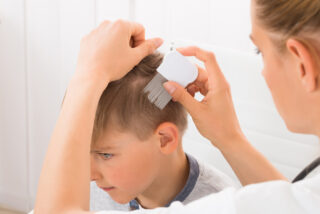
More Child Health and Safety Articles
Could Your Child Have Head Lice?

Head lice, these tiny insects, take up residence on people’s scalps and make their way into their hair. By biting the scalp, head lice feed on human blood. The issue of head lice has persisted for thousands of years, even evident in Egyptian mummies. Remarkably, head lice affect more school-aged children than all other contagious illnesses combined, excluding the common cold.
Initially, it may not be immediately apparent that your child has head lice. It takes about 4-6 weeks for the body’s immune system to develop sensitivity to the bites. During this period, a female louse can lay 6-10 nits per day. These nits take approximately two weeks to hatch, mature, and commence laying more eggs. By the time you detect an infestation, multiple generations of lice may already be residing in your child’s hair.
You might suspect your child has head lice if they exhibit the following indications:
- Expressing discomfort from a tickling sensation or sensing movement in the hair.
- Experiencing itching due to a reaction to the lice bites.
- Demonstrating irritability.
- Developing sores on the head as a result of scratching.
Scratch marks on the scalp, particularly behind the ears or at the nape of the neck, serve as telltale signs of a head lice infestation.
How Can You Eliminate Head Lice?
It is advisable to seek treatment if even a single nit is found. There are two effective methods for eliminating lice: manually removing the nits using a comb and employing a special shampoo. The most effective approach is a combination of both. To learn how to comb out nits and treat your child’s belongings and home, you can consult your pharmacist, healthcare provider, or school nurse.
Two types of shampoo, available without a prescription, can be used. One type utilizes a pesticide to eradicate the nits, while the other employs a pesticide-free cosmetic cleanser to eliminate lice and aid in dissolving the glue that attaches the nits to the hair shaft. If you are uncertain about which treatment to choose or how to use it, don’t hesitate to ask your pharmacist or healthcare provider. It is crucial to always follow the directions provided when using any lice-removal product.
Preventing Head Lice Reinfestation
Reinfestation is always a possibility. If the source of the original infestation is not addressed—for example, a classroom with many infested children—reinfestation is likely.
Remember that each day brings a new risk of encountering a fresh infestation. For at least two weeks after treatment, diligently inspect all family members daily. If you discover head lice on your child, notify their school, camp, and childcare provider. Inquire about their “nit policy” and determine when your child can safely return to the classroom. Inform other parents in your neighborhood as well. While reporting an infestation may seem embarrassing, it is the most effective way to ensure that the problem is resolved at its source.
Teach your child not to share or borrow personal items such as combs, headbands, hair ribbons, scarves, hats, headphones, sports helmets, towels, blankets, and stuffed toys. Educate them about avoiding head-to-head contact with other children. Additionally, store clothing (like hats, hooded jackets, and scarves) and personal items (such as pillows, bedding, combs, brushes, and stuffed toys) in a manner that prevents them from touching. Request that your child’s school or daycare adopts the same practice, including not sharing cubbies or lockers among children.
Other Articles You May Find of Interest...
- Nurturing Emotional Resilience in Children: A Guide For Parents
- Springtime Allergies: Exploring Holistic Options For Relief
- Healthy Snacks For Your Children
- Twelve Valuable Parenting Principles
- Nurturing Healthy Sleep Habits in Infants and Toddlers
- Children’s Health and Spring Time
- Chiropractic Care For Your Child

















